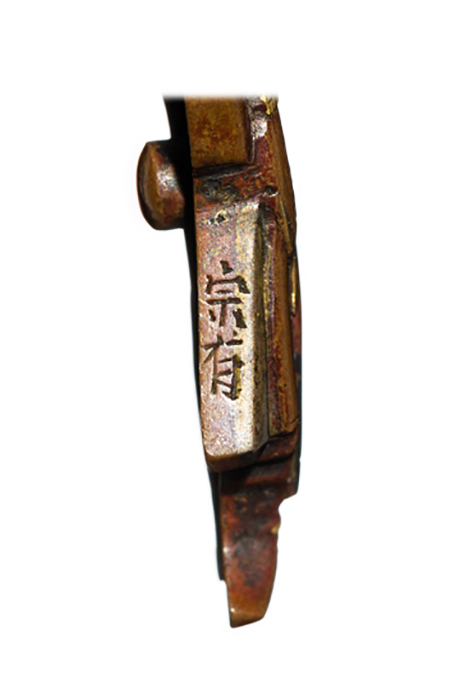日貫 銘、宗有(奈良利治)
鬼鍾馗图
Nara Menuki
Signed: Soyu (Nara Toshiharu)
Shoki & Oni motif
Dimensions: 12 mm x 33 mm each
Hakogaki by Kanzan Sato
Showa 38 (1963) NBTHK Tokubetsu Kicho Nintei-sho
Published in the 12th Kokusai Tosogu Kai Volume (2016)
This is an Edo period menuki by Nara Toshiharu. Nara Toshiharu was the son of Toshimune. He was the second head of the Nara school. Toshiharu and his aon Toshinaga are said to be the best kinko artists of the Nara main-line. Toshiharu is ranked at the Yuko (3rd) level by Wakayama. Toshiharu was born in 1593. This meunki bears his late in life mei of "Soyu". He used this mei after he became a lay priest. There are works that state "age 68", "age 71" and "age 85" with the Nara Soyu mei in existence. Earlier dated works with the mei of Nara Toshiharu and Bushu Edo ju Nara Toshiharu both exist from the 3rd year of Kanbun. It is also reported that there was a tsuba by Toshiharu with the mei of "Bushu Edo ju Nara Kozaemon" and dated as Enpo 4th year. Based on the above research, we can date this set of menuki to around 1663-1678.
The theme of this work is that of Shoki and the Oni at Setsubun. The theme of Shoki and the Oni is often encountered in tososgu. The characters come from Tang dynasty Chinese lore. There are several versions of the tale. The most common one is that Shoki submitted to an imperial exam in the area of literature and martial arts. He did well but was so unsightly in his appearance that the Emperor refused him the position. Shoki was horribly distraught by this and he committed suicide. The Emperor heard the story and posthumously awarded Shoki the position, even burying him with royal honors. Shoki's spirit thereafter vowed to protect the emperor and the empire from evil, which the Oni represents.
Setsubun is the day before the beginning of spring in Japan. It is also called Risshun and is celebrated yearly on February third. Part of this is the tradition is mamemaki (literally "bean scattering"). This ritual first appeared in the Muromachi period. It is usually performed by the toshi-otoko (the male who was born on the corresponding animal year on the Chinese zodiac), or the male head of the household. Roasted soy beans are thrown either out the door or at a member of the family wearing an Oni mask while everyone says "Demons out! Luck in!"
Shoki, "the demon queller", is depicted here with his sword at his side and umbrella closed while the Oni finds cover under his own umbrella. The umbrellas are shelter from the beans being thrown. The Oni is also holding a "chochin" or "carrying lantern", which were used during the old days for traveling at night time and for the lights of the Setsubun festival. The sense of humor shown by Toshiharu here is delightful. The Oni's umbrella is tattered and torn, providing him little shelter from the onslaught of the beans.
Details such as the coloring and shadows on the copper base, gold eyes of the figures, shakudo elements, modeling of the muscles in the Oni's arms, the teeth and toes of the Oni, Shoki's beard, the gold handle of the chochin, the torn lantern detail in gold nunome, sukashi holes in the Oni's umbrella with gold nunome spokes, etc..... all are key points of appreciation that are expected details in jishin saku works by skilled machibori craftsman. It should also be noted that this set of menuki has male and female posts on the backs. Many old menuki were made this way and it is a point to check for in kantei. The signature is carefully placed on the side of the menuki, as to not interfere with the design. The details of the workmanship are wonderful, but the life given to the characters in their facial expressions is as important as the technical skill of the work. The personality of tosogu, especially the facial expressions of figures, can multiply the enjoyment of the craftsmanship greatly. Such is the case with this Nara Toshiharu menuki.
SOLD
nihontocraft@bellsouth.net

|
|
|





